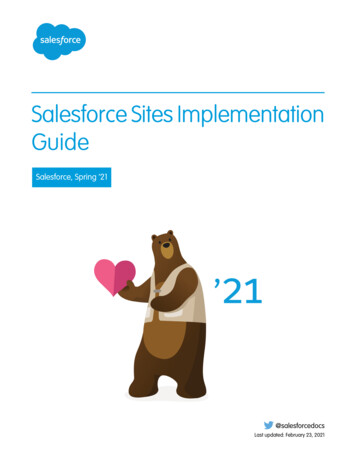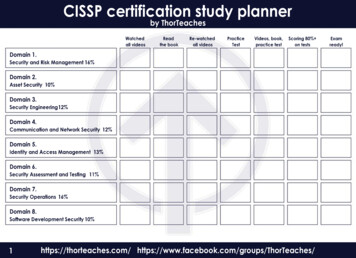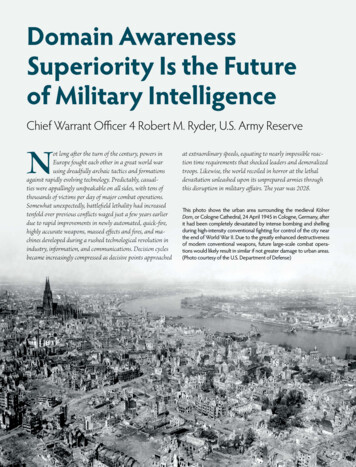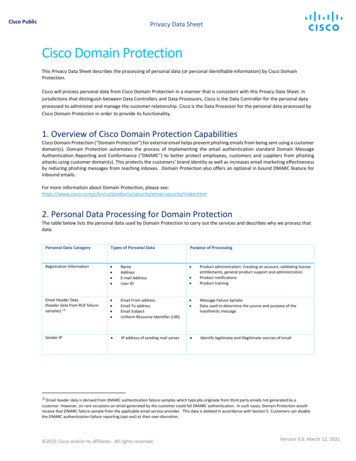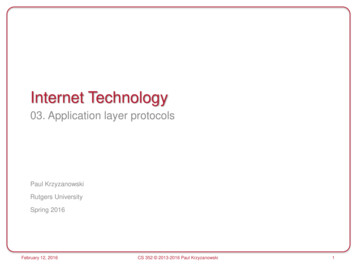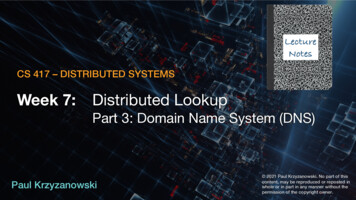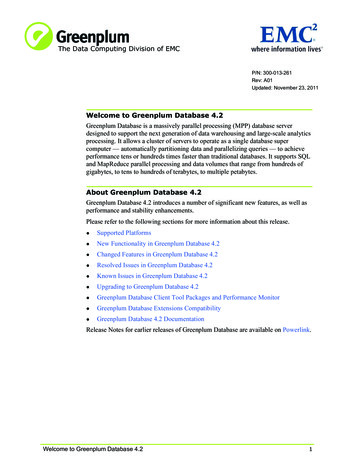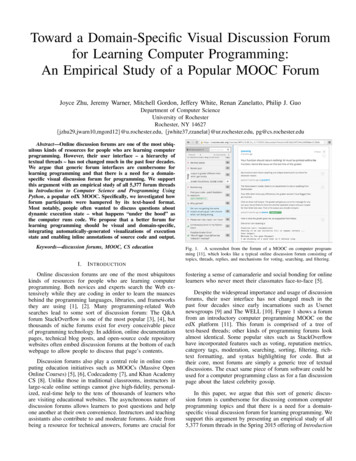
Transcription
Toward a Domain-Specific Visual Discussion Forumfor Learning Computer Programming:An Empirical Study of a Popular MOOC ForumJoyce Zhu, Jeremy Warner, Mitchell Gordon, Jeffery White, Renan Zanelatto, Philip J. GuoDepartment of Computer ScienceUniversity of RochesterRochester, NY 14627{jzhu29,jwarn10,mgord12}@u.rochester.edu, {jwhite37,rzanelat}@ur.rochester.edu, pg@cs.rochester.eduAbstract—Online discussion forums are one of the most ubiquitous kinds of resources for people who are learning computerprogramming. However, their user interface – a hierarchy oftextual threads – has not changed much in the past four decades.We argue that generic forum interfaces are cumbersome forlearning programming and that there is a need for a domainspecific visual discussion forum for programming. We supportthis argument with an empirical study of all 5,377 forum threadsin Introduction to Computer Science and Programming UsingPython, a popular edX MOOC. Specifically, we investigated howforum participants were hampered by its text-based format.Most notably, people often wanted to discuss questions aboutdynamic execution state – what happens “under the hood” asthe computer runs code. We propose that a better forum forlearning programming should be visual and domain-specific,integrating automatically-generated visualizations of executionstate and enabling inline annotations of source code and output.Keywords—discussion forums, MOOC, CS educationI.Fig. 1. A screenshot from the forum of a MOOC on computer programming [11], which looks like a typical online discussion forum consisting oftopics, threads, replies, and mechanisms for voting, searching, and filtering.I NTRODUCTIONOnline discussion forums are one of the most ubiquitouskinds of resources for people who are learning computerprogramming. Both novices and experts search the Web extensively while they are coding in order to learn the nuancesbehind the programming languages, libraries, and frameworksthey are using [1], [2]. Many programming-related Websearches lead to some sort of discussion forum: The Q&Aforum StackOverflow is one of the most popular [3], [4], butthousands of niche forums exist for every conceivable pieceof programming technology. In addition, online documentationpages, technical blog posts, and open-source code repositorywebsites often embed discussion forums at the bottom of eachwebpage to allow people to discuss that page’s contents.Discussion forums also play a central role in online computing education initiatives such as MOOCs (Massive OpenOnline Courses) [5], [6], Codecademy [7], and Khan AcademyCS [8]. Unlike those in traditional classrooms, instructors inlarge-scale online settings cannot give high-fidelity, personalized, real-time help to the tens of thousands of learners whoare visiting educational websites. The asynchronous nature ofdiscussion forums allows learners to post questions and helpone another at their own convenience. Instructors and teachingassistants also contribute to and moderate forums. Aside frombeing a resource for technical answers, forums are crucial forfostering a sense of camaraderie and social bonding for onlinelearners who never meet their classmates face-to-face [5].Despite the widespread importance and usage of discussionforums, their user interface has not changed much in thepast four decades since early incarnations such as Usenetnewsgroups [9] and The WELL [10]. Figure 1 shows a forumfrom an introductory computer programming MOOC on theedX platform [11]. This forum is comprised of a tree oftext-based threads; other kinds of programming forums lookalmost identical. Some popular sites such as StackOverflowhave incorporated features such as voting, reputation metrics,category tags, moderation, searching, sorting, filtering, richtext formatting, and syntax highlighting for code. But attheir core, most forums are simply a generic tree of textualdiscussions. The exact same piece of forum software could beused for a computer programming class as for a fan discussionpage about the latest celebrity gossip.In this paper, we argue that this sort of generic discussion forum is cumbersome for discussing common computerprogramming topics and that there is a need for a domainspecific visual discussion forum for learning programming. Wesupport this argument by presenting an empirical study of all5,377 forum threads in the Spring 2015 offering of Introduction
FindingDesign RecommendationThe majority of discussion forum threads in this course ( 60%) mentionedexecution state, code snippets, output/errors, or autograder complaints.A forum optimized for learning programming must support inline anchored discussionsaround these topics, eliminating the need to copy-and-paste into disconnected threads.Generic forums have no built-in way of visualizing execution state, so postersmust resort to indirect textual explanations or manually-drawn diagrams of state.A forum should integrate with a program visualization tool that automatically rendersdiagrams of code execution state, eliminating the need for manually-drawn diagrams.Generic forums are not designed for holding rich conversations around source code;they treat code simply as plain text with some optional formatting.A forum should treat code not as blocks of plain text, but rather as first-class objectsthat can be annotated, versioned, and linked to code posted by other students.Generic forums are not linked with a code execution engine, so they cannoteffectively capture discussions and experimentation around program output/errors.A forum should tightly integrate with an IDE (Integrated Development Environment)so that students can execute code, see output/errors, and discuss them within the IDE.The autograder is a central component of programming courses, but how it worksis often unclear to students. Thus, some discussions involve complaints about it.A program visualization tool can visualize how the autograder works; integrating theforum with these visualizations allows students to more easily discuss grading issues.TABLE I.S UMMARY OF FINDINGS AND ACCOMPANYING DESIGN RECOMMENDATIONS FROM OUR STUDY OF 5,377 DISCUSSION FORUM POSTS IN APOPULAR COMPUTER PROGRAMMING MOOC.to Computer Science and Programming Using Python [11], apopular MOOC released by MIT on the edX platform.Specifically, we investigated how forum participants werehampered by the limitations of its text-based format. Mostnotably, people often wanted to discuss questions about dynamic execution state – what happens “under the hood” as thecomputer runs a piece of code. This observation corroboratesthe fact that one of the fundamental challenges of learningprogramming is developing a robust mental model of dynamic execution state [12], [13]; without good mental models,novices are susceptible to hundreds of well-documented misconceptions about how their code works [14] and cannot writereliable programs of any significant size. But it is hard to talkabout execution state in an ordinary text-based forum sincerun-time concepts such as stack frames, variables, pointers,objects, and data structure shapes are invisible. Students mustnow copy-and-paste snippets of code and text output from theterminal into their posts, and then indirectly talk about runtime semantics. There is no easy way to visualize this state.Table I summarizes all of our study’s findings and accompanying design recommendations. In sum, we propose that abetter forum for learning programming should be visual anddomain-specific in nature, tightly integrating automaticallygenerated visualizations of execution state [15] and enablinginline annotations of both source code and program output.Discussion forums are one of the longest-enduring formsof online knowledge sharing, but a purely text-based formatignores the rich nuances of each domain and hinders theirpotential as an educational tool. There is no one-size-fitsall solution, though; intuitively, the ideal forum for learningworld history should look very different from the ideal onefor learning computer programming. Our goal in this paper isto uncover some of the limitations of using generic forums forcomputing education in particular.Our study is the first step toward informing the designof the next generation of forums for programming, whichcan benefit a broad audience due to the growing importanceof computational thinking across many fields of work [16].As more people of all backgrounds learn programming fromonline resources, it is important to provide them with the bestpossible medium for seeking help and fostering discussions,especially about technical topics that are cumbersome todiscuss using generic forum interfaces.This paper’s contributions are: An empirical study of all 5,377 discussion forumposts in a popular computer programming MOOC,which shows how a generic text-based forum format iscumbersome for discussing four topics that were mentioned in many threads: execution state, code snippets,program output/errors, and autograder complaints. A proposal for the design of a new kind of domainspecific visual discussion forum for learning programming, informed by the findings of our study. Ourforum design integrates inline anchored discussionsand program visualizations into a Web-based IDE.II.BACKGROUND AND R ELATED W ORKOnline discussion forums have been a staple of Internet culture for almost four decades, starting with Usenet newsgroupsand bulletin board systems (BBS) in the 1970s [9] and TheWELL [10] in the 1980s. Due to limited computational powerand network bandwidth at the time, these early forums wereall text-based, with conversations grouped into hierarchies(trees) of threads. When Web forums started in the 1990s,they simply replicated this text-based threaded format thathas now become ubiquitous. Numerous forums now exist fortopics ranging from parenting [17] to mathematics [18]. Inthe 2000s, question-and-answer (Q&A) sites such as Yahoo!Answers [19], [20], StackOverflow [3], [4], the StackExchangenetwork [21], [22], and Quora [23] grew popular. These sitesshare the same format as traditional forums, except that eachthread starts with a question, followed by a series of answersthat users can vote on so that the best one rises to the top.Although the majority of forums are purely text-based,several kinds of niche forums have incorporated domainspecific interface features. For instance: Image-based forums (called imageboards) make iteasy to post images alongside text. One of the mostpopular, 4chan, combines a focus on images withan ephemeral format where posts are usually deletedwithin 4 minutes as incoming posts replace them [24]. StackOverflow [3], [4] and other forums for computerprogramming enable posters to write code in indentedblocks with syntax highlighting to improve readability.
Mathematics forums such as MathOverflow [18] enable posters to write math formulas in LaTeX.One forum interface variant used in education is calledanchored discussions [25], where each piece of course content(e.g., lecture note, video, assignment) is tightly connected toits own mini-forum. Guzdial and Turns created the CaMILEsystem and found that anchoring improved on-topic discussions and led to better learning in their classes [26]. Zyto etal. took this idea further with NB [27], a Web-based systemthat allows students to annotate and hold discussions directlyin the margins of PDF documents. NB enables students to askand answer questions in real-time while they are in the flow ofreading online lecture notes or digital textbooks. Many modernonline learning systems such as Khan Academy and MOOCsfeature a combination of anchored and traditional forums.videos and homework assignments that involved programmingin the Python language. There was also a midterm and finalexam. The discussion forum (Figure 1) was the officiallysanctioned way for students to communicate with one anotherand with the course staff. In total, 4,267 people posted messages to 5,377 threads. The forum was very active, with anaverage of 84 new threads being created every day, and eachthread’s initial post receiving an average of 1.8 replies.Most people posting to the forum were normal students,but there was also one instructor and 5 assistants calledCommunity TAs. A Community TA is a current student who hasestablished a good reputation for being helpful, responsible,and respectful on the forum, so the instructor has given themmoderation privileges. Unlike normal students, the instructorand Community TAs can edit and delete anyone’s posts.Forums are the primary way in which students communicate with each other and with instructors in MOOCs [5].Researchers have studied aspects of forums such as collaborative learning [28], reputation systems [6], power-user behavior [5], and read-only (lurking) behavior [29]. However, priorstudies of MOOC forums have not focused on any particulardomain of learning, but rather on general student behaviorirrespective of subject matter. The study in this paper focuseson computer programming MOOCs, with an eye toward howto improve the forum’s user interface to support discussionsabout programming-related topics.Aside from being a standalone section of the course website, the forum is also embedded within all other componentsof the course. For instance, when a student is watching aparticular lecture video, they can ask questions about it at thebottom of the page, and those will automatically be posted tothe forum and tagged with the proper context (e.g., “Week 2:Lecture 4”). This is an example of anchored discussions [25],[26], which brings discussions closer to the course content.Researchers in computer-mediated communication havestudied the myriad ways in which people interact with oneanother on forums across diverse domains [19], [20], [28],[17], [3], [4], [21], [23], [18], [22], [5], [6]. Although manysuch studies take the forum’s user interface as a given, severalhave suggested design improvements. For instance, researcherswho study software bug tracking systems [30], [31], [32] andproduct support forums [33] have suggested improvements tothese kinds of interfaces to improve the workflows of softwaredevelopers and support specialists, respectively.We scraped data from the edX website and wrote scripts toautomatically identify features such as poster identities, threadlengths, and screenshots. However, it was hard to automaticallycategorize the actual content of threads, so we relied on manuallabeling from six experienced Python programmers.Our study focuses on how students use a text-basedthreaded forum to discuss common elements within a computerprogramming course and then proposes ways in which the forum’s user interface could be improved to better accommodatethese discussions. Our study is unique in that it turns a criticaleye on discussion forum interfaces in the domain of onlinelearning at scale, which prior work has not investigated, andsuggests improvements for computing education in particular.III.A. Manually Labeling Forum PostsFirst, two researchers – the first and last author – separatelyread a random sample of 200 threads and performed anopen card sort to identify the most salient topics that werediscussed in those threads, especially those that frequently ledto frustrations with the forum’s user interface. They convergedon four topics that were present in many of those threads: Execution state: Students often discussed dynamicproperties of run-time state by describing what theythink happens at each step of execution. For instance,one post tried to explain some exception handlingcode: “The else clause will only run if NO erroroccurs. In this instance the divide by 0 error occurs,so the else does not execute. The finally clause executes, then the divide by 0 is thrown to the systemhandler.” Confusions stemmed from students’ inabilityto visualize what their words were referring to. Code snippets: Students wrote or copied-and-pastedsnippets of code into posts. Some knew how to useproper markup to have code appear in formattedblocks, but others did not, so their code ended uplooking badly formatted. This led to subtle misunderstandings since indentation is significant in Python. Output/errors: Students copied-and-pasted the textual output or errors from code execution into theirposts. Again, improper text formatting was a cause ofmany frustrations, as was the sheer amount of outputthat some programs dumped to the terminal.M ETHODOLOGYWe analyzed discussion forum posts from the Spring 2015offering of MITx 6.00.1x: Introduction to Computer Scienceand Programming Using Python [11], a free MOOC (MassiveOpen Online Course) released by MIT on the edX platform.We chose to study this course because it is an introductoryprogramming MOOC from one of the major providers (edX),has been offered four times before, and is based on MIT’spopular introductory programming course that is taken by bothCS majors and non-majors. This course has no prerequisitesand is targeted at absolute beginners, although it aims to bejust as rigorous as its on-campus MIT counterpart [34].This course ran for nine weeks, from January 7 to March11, 2015. Each week, the staff released a new set of lecture
a.) Total 4,4213,619# ion stateCode snippetsOutput/errorsAutograder complaintsT HE NUMBER ( AND PERCENT ) OF THREADS IN THE DISCUSSION FORUM OF THE ED X MOOC Introduction to Computer Science andProgramming Using Python THAT MENTIONED EACH OF OUR FOUR MANUALLY- LABELED TOPICS .Autograder complaints: Finally, students complainedabout the autograder – the automatic grading softwarethat checks the correctness of every programmingassignment. The autograder works by running thestudent’s Python code on a collection of test inputs andcomparing the outputs to instructor-created answers.Complaints often stemmed from the autograder interface being too opaque, simply telling the user whethereach part was right or wrong, but not how or why.After finalizing the topics, we recruited the remainingauthors (six total) to manually label all 5,377 forum threads according to which of the above topics were present in each one.We split threads into six groups so that each researcher labeled896 of them. All six were experienced Python programmers.To determine inter-rater reliability, all six researchers labeled the same random sample of 50 threads (1% of totalthreads). The Fleiss’ kappa scores amongst six raters were0.40 for identifying a thread as containing execution state,0.76 for code snippets, 0.57 for output/errors, and 0.62 forautograder complaints. 1.0 means perfect agreement, so thesescores indicate moderate agreement. Two factors lowered ourscores: having more raters tends to lower the scores, andthere was subjectivity involved in picking out topics (especiallymentions of execution state) embedded within blocks of text.The rest of this paper describes our findings and designrecommendations, which are summarized in Table I.IV.c.) Not General/Week1 and has replies# threads with some topic####TABLE II.b.) Not General/Week1Q UANTITATIVE F INDINGS : P REVALENCE OF T OPICSBefore describing specific examples of user frustrationswith the forum’s interface, we first present numbers to showhow prevalent our four labeled topics were throughout theforum. Establishing prevalence is important because if thesetopics comprise only a tiny fraction of forum posts, then itis not worth trying to redesign future computing educationdiscussion forums to accommodate them.Table II shows that the majority of threads contained atleast one of the four topics. The first column – “a.) Total”– considers all 5,377 threads in the course, where 57%were labeled with at least one topic. Many threads containedmultiple topics. The three most common co-occurrences were:70% of execution state threads also showed code snippets (thusconveying both static and dynamic properties of code), 44%of autograder complaint threads also showed output/errors, and22% of execution state threads also showed output/errors.To see how prevalent these topics were in the most activeand relevant threads, we filtered using two criteria: First, manythreads in Week 1 involved course logistics and software setup# attached images# images with some xecution stateCode snippetsOutput/errorsAutograder )TABLE III.N UMBER OF IMAGES ATTACHED TO FORUM THREADS THATDISPLAYED EACH TOPIC . ( † V ERY FEW DISPLAYED EXECUTION STATESINCE THE FORUM HAD NO BUILT- IN WAY OF VISUALIZING THIS STATE .)problems since there was not a programming assignment dueyet; thus, that first week was not representative of the rest ofthe course. Also, threads posted to a catch-all “General” areaof the forum were side discussions that had little bearing onthe core course material. We filtered out those posts to createthe second column in Table II – “b.) Not General/Week1” –where 62% had at least one labeled topic. Next, we saw thatthreads with no replies were often badly-worded, off-topic,or otherwise incomprehensible. Regardless of cause, studentsand teaching staff did not try to engage with those threads.We filtered those out to create the third column in Table II –“c.) Not General/Week1 and has replies.” These are likely to bethreads that covered core course material and had engagement.72% of these threads had some labeled topic, and over onethird showed either execution state or code snippets.Image attachments: In addition to mentioning these topicsin the text itself, people sometimes attached images to poststo illustrate them. 5% of total threads included some imageattachment, which renders inline alongside the text.Table III shows that out of 257 attached images, 68%illustrated one of our four topics. Many attachments werescreenshots taken of either the edX website or of an externalpiece of software. Only 5% showed execution state; this lowproportion was likely due to the forum having no built-inmeans for visualizing such state, so posters had to turn toexternal tools. For instance, in Figure 2, the poster attached ascreenshot from a Python program visualization tool [15] toaccompany their explanation of execution state.Images containing code snippets, output/errors, and autograder complaints – which together comprise 63% of images– were usually screenshots of the online code editor or textoutput window on the edX website. The fact that studentsresorted to taking screenshots of plain-text content to includein forum posts indicates that the forum’s user interface for textentry is inadequate for their needs. One likely reason they tookscreenshots rather than simply copying-and-pasting text was topreserve spacing and indentation; some also drew annotations
Fig. 3.A post that shows code, program output, and an inline imageattachment made using an external drawing tool.Fig. 4.Fig. 2. A forum post with an inline image attachment that is a screenshottaken from an external program visualization tool (Online Python Tutor [15]).Also, note that the code mentioned in this post is not properly formatted.atop the screenshots to highlight selected portions.Summary: The majority of discussion forum threads in thiscourse ( 60%) mentioned execution state, code snippets,output/errors, or autograder complaints. Thus, improvinghow these topics are rendered could have a noticeable impacton future forums for computer programming courses.V.R EPRESENTATIVE E XAMPLES OF P OST T OPICSWe now describe the most commonly-seen examples ofeach topic and summarize user frustrations with each.A. Execution stateDecades of computing education research have shown thatdeveloping a robust mental model of program execution is afundamental skill for becoming a competent programmer [12],[13], [14]. This finding is supported by the fact that one of themost common kinds of discussions that occurred in the forumwas about dynamic execution state – i.e., what happens “underthe hood” as the computer executes a piece of code step bystep. However, the plain-text format of the forum is not wellsuited for holding conversations about the two major aspectsof execution state: control flow and data structure values. Hereare two representative posts about control flow:A post with an image attachment that is a hand-drawn diagram.“Q1-3: I try the code and don’t get an IndexException, therefore itshould run the else clause, shouldn’t it? So why it only prints thefinally statement and then gives an error message? Q2-2: I get it thatwhen it gets an IndexError it changes the function and run the codeagain. But why the answer is not 0, 1, 0 meaning that after changingthe function it printed the finally and then printed the else and finallyagain? Q3-3: why don’t I print 1 on the else clause after I pass theexcept clause?”“I wonder if someone would be kind enough to explain the flowof control with a call to fib(x-1) and fib(x-2) in the same statement(expression?). Does the function call all of the (x-1) first andreturn those and then call all of the (x-2) values, or does it call bothof them at the same time for the same value of n?”These kinds of posts are typically followed by a series ofconfusing replies where students try to articulate what theythink is happening as the code executes. But there is no wayfor them to see and discuss what actually happens duringexecution, since the forum is not integrated with a debugger.To discuss run-time values of data structures, studentseither tried describing how the data looks in their post orattached images containing screenshots taken from an automated program visualization tool (Figure 2), drawings froman illustration tool (Figure 3), or even pictures taken of handdrawn sketches (Figure 4). Again, text is not well-suited forconveying concepts that are better conveyed as visualizations,but standard forums have no such visualization capabilities.
Fig. 5.A post showing a block of unformatted (presumably pasted) code.Summary: Generic forums have no built-in way of visualizing execution state, so posters must resort to indirect textualexplanations or screenshots from external applications.B. Code snippetsStudents often copied and pasted code snippets into theirposts (Table II), which is expected since this is a programmingintensive course. Although the forum had a “format-as-a-codeblock” feature, many students did not know how to use it, sotheir code ended up looking like an unindented mess, as shownin Figure 5. Although this issue seems superficial, if someone’scode is hard to comprehend, then others may be less likely torespond with useful help, or even to respond at all.Students also interspersed code with accompanying explanations or questions, again without using special fonts todemarcate their code. Here is a short example: “Why doestype(varA) or type(varB) str always evaluate to True?”Although experienced programmers know how to parse thesesentences, novices unfamiliar with Python syntax can havetrouble telling which parts are code and which are English.When someone is replying to a post containing code, theycannot directly point to specific parts like people can do if theyare sitting in front of the same computer debugging together.So students referred to previously-posted code by copyingand pasting it into their replies, and then making edits oradding comments. This behavior resulted in threads where thesame code snippet was repeated multiple times with minorvariations, which made it hard to hone in on meaningful diffs.Presumably to avoid formatting issues, some students tookscreenshots of their code editor, drew arrows to highlightcertain parts, and then pasted those images into posts. Butdoing so prevents others from copying and pasting the codeinto their replies, thus hindering further discussion.Summary: Generic forums are not designed for holding richconversations around source code; they treat code simply asplain text with some optional formatting.C. Output/errorsStudents often copied and pasted outputs and error messages from program executions into their posts to ask aboutwhat went wrong. Just like with code snippets, many did notknow how to use the “format-as-a-code-block” feature, whichresulted in threads being littered with unformatted blobs oftext. To avoid formatting problems, some students attachedFig. 6. A post complaining about output discrepancies with the autograder,using an attached screenshot with one part underlined in blue.screenshots of their terminal output and highlighted specificlines (Figure 6).Even if formatting were not an issue, the sheer volume ofoutput and/or error messages dominated some threads. Sincenovices did not know which parts were significant, they simplycopied and pasted everything in their terminal, which made ithard for others to read and refer to specific parts in their replies.Discussions about output and errors were hampered bythe fact that nobody could reproduce the original executionsthat created those outputs or edit the poster’s original codeto debug the underlying issues. All people could do was readlong blobs of text and speculate on what they think happenedin the original code to produce that text. In contrast, if peoplewere sitting in front of the same computer debugging andexperimenting together, they could directly edit the code andre-execute to see how their changes affect the output and errors.Summary: Generic forums are not linked with an underlyingcode execution engine, so they cannot effectively capture discussions and experimentation around program output/errors.D. Autograder complaintsThe final major topic we saw in the forum was complaintsabout the autograder software that checks the correctnessof programming assignments. Since it is tedious to manually grade student assignments, many computer programmingcourses
used for a computer programming class as for a fan discussion page about the latest celebrity gossip. In this paper, we argue that this sort of generic discus-sion forum is cumbersome for discussing common computer programming topics and that there is a need for a domain-specific visual discussion forum for learning programming. We

